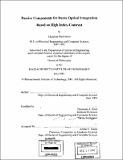| dc.contributor.advisor | Hermann A. Haus. | en_US |
| dc.contributor.author | Manolatou, Christina | en_US |
| dc.contributor.other | Massachusetts Institute of Technology. Dept. of Electrical Engineering and Computer Science. | en_US |
| dc.date.accessioned | 2005-09-26T19:25:05Z | |
| dc.date.available | 2005-09-26T19:25:05Z | |
| dc.date.copyright | 2001 | en_US |
| dc.date.issued | 2001 | en_US |
| dc.identifier.uri | http://hdl.handle.net/1721.1/28259 | |
| dc.description | Thesis (Ph. D.)--Massachusetts Institute of Technology, Dept. of Electrical Engineering and Computer Science, 2001. | en_US |
| dc.description | Includes bibliographical references (p. 181-185). | en_US |
| dc.description.abstract | This work presents a theoretical and numerical investigation of high index-contrast passive components that can serve as building blocks at the end-pointsand nodes of WDM communications systems. The main characteristic of these structures is their miniature size (on the order of the optical wavelength), and their low radiation loss due to the strong light confinement in high index-contrast systems. Thus large scale, high density optical integration may be possible with the associated advantages of increased functionality, compactness and low-cost. Novel devices for filtering, optical interconnections and coupling to fibers are presented, specifically: a class of resonant add/drop filters that rely on symmetry and degeneracy of modes, low-loss right-angle bends, splitters, crossings based on transmission cavities, and fiber-chip couplers based on cascades of resonators or lensing mechanisms. Their operating principles are explained and an approximate analysis is obtained by analytical methods such as coupled-mode theory and gaussian/ray optics. For accurate analysis and optimized design, extensive numerical simulations are performed using the Finite Difference Time Domain method. The numerical results are in good agreement with the experimental data obtained for bends that were farbricated and tested at MIT. Issues that remain to be addressed for this technology to be viable and possible future directions are also discussed. | en_US |
| dc.description.statementofresponsibility | by Christina Manolatou. | en_US |
| dc.format.extent | 185 p. | en_US |
| dc.format.extent | 10164864 bytes | |
| dc.format.extent | 10187953 bytes | |
| dc.format.mimetype | application/pdf | |
| dc.format.mimetype | application/pdf | |
| dc.language.iso | en_US | |
| dc.publisher | Massachusetts Institute of Technology | en_US |
| dc.rights | M.I.T. theses are protected by copyright. They may be viewed from this source for any purpose, but reproduction or distribution in any format is prohibited without written permission. See provided URL for inquiries about permission. | en_US |
| dc.rights.uri | http://dspace.mit.edu/handle/1721.1/7582 | |
| dc.subject | Electrical Engineering and Computer Science. | en_US |
| dc.title | Passive components for dense optical integration based on high index-contrast | en_US |
| dc.type | Thesis | en_US |
| dc.description.degree | Ph.D. | en_US |
| dc.contributor.department | Massachusetts Institute of Technology. Department of Electrical Engineering and Computer Science | |
| dc.identifier.oclc | 52052722 | en_US |
